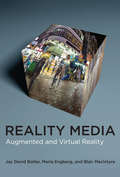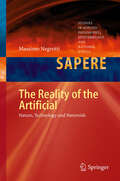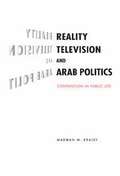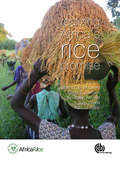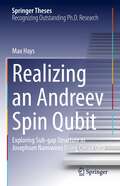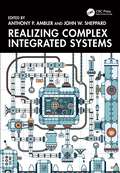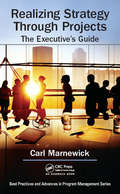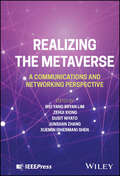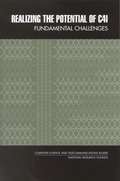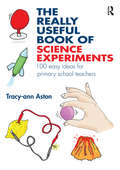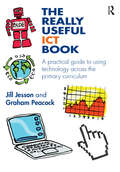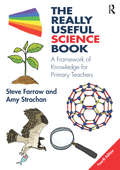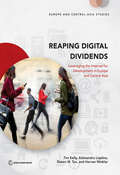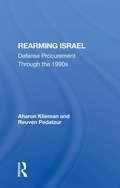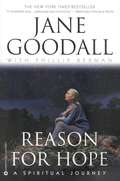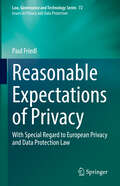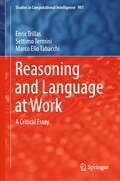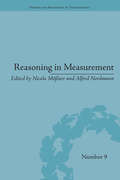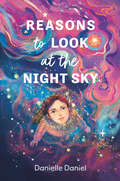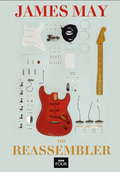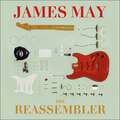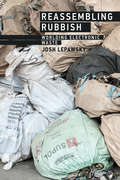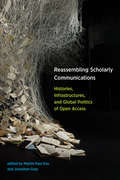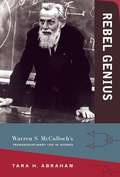- Table View
- List View
Reality Media: Augmented and Virtual Reality
by Jay David Bolter Maria Engberg Blair MacIntyreHow augmented reality and virtual reality are taking their places in contemporary media culture alongside film and television.TThis book positions augmented reality (AR) and virtual reality (VR) firmly in contemporary media culture. The authors view AR and VR not as the latest hyped technologies but as media—the latest in a series of what they term &“reality media,&” taking their places alongside film and television. Reality media inserts a layer of media between us and our perception of the world; AR and VR do not replace reality but refashion a reality for us. Each reality medium mediates and remediates; each offers a new representation that we implicitly compare to our experience of the world in itself but also through other media. The authors show that as forms of reality media emerge, they not only chart a future path for media culture, but also redefine media past. With AR and VR in mind, then, we can recognize their precursors in eighteenth-century panoramas and the Broadway lights of the 1930s. A digital version of Reality Media, available through the book&’s website, invites readers to visit a series of virtual rooms featuring interactivity, 3-D models, videos, images, and texts that explore the themes of the book.
The Reality of the Artificial
by Massimo NegrottiThe human ambition to reproduce and improve natural objects and processes has a long history, and ranges from dreams to actual design, from Icarus's wings to modern robotics and bioengineering. This imperative seems to be linked not only to practical utility but also to our deepest psychology. Nevertheless, reproducing something natural is not an easy enterprise, and the actual replication of a natural object or process by means of some technology is impossible. In this book the author uses the term naturoid to designate any real artifact arising from our attempts to reproduce natural instances. He concentrates on activities that involve the reproduction of something existing in nature, and whose reproduction, through construction strategies which differ from natural ones, we consider to be useful, appealing or interesting. The development of naturoids may be viewed as a distinct class of technological activity, and the concept should be useful for methodological research into establishing the common rules, potentialities and constraints that characterize the human effort to reproduce natural objects. The author shows that a naturoid is always the result of a reduction of the complexity of natural objects, due to an unavoidable multiple selection strategy. Nevertheless, the reproduction process implies that naturoids take on their own new complexity, resulting in a transfiguration of the natural exemplars and their performances, and leading to a true innovation explosion. While the core performances of contemporary naturoids improve, paradoxically the more a naturoid develops the further it moves away from its natural counterpart. Therefore, naturoids will more and more affect our relationships with advanced technologies and with nature, but in ways quite beyond our predictive capabilities. The book will be of interest to design scholars and researchers of technology, cultural studies, anthropology and the sociology of science and technology.
Reality Television and Arab Politics: Contention in Public Life
by Marwan M. KraidyWhat does it mean to be modern outside the West? Based on a wealth of primary data collected over five years, Reality Television and Arab Politics analyzes how reality television stirred an explosive mix of religion, politics, and sexuality, fuelling heated polemics over cultural authenticity, gender relations, and political participation in the Arab world. The controversies, Kraidy argues, are best understood as a social laboratory in which actors experiment with various forms of modernity, continuing a long-standing Arab preoccupation with specifying terms of engagement with Western modernity. Women and youth take center stage in this process. Against the backdrop of dramatic upheaval in the Middle East, this book challenges the notion of a monolithic "Arab Street" and offers an original perspective on Arab media, shifting attention away from a narrow focus on al-Jazeera, toward a vibrant media sphere that compels broad popular engagement and contentious political performance.
Realizing Africa's Rice Promise
by Marco C.S. Wopereis David E. Johnson Nourollah Ahmadi Eric Tollens Abdulai Jalloh*Includes contributions from the key scientists working in the area *Provides a comprehensive overview of the latest research as well as making recommendations for how best to deal with future challenges *Has a wide and varied scope – covering policy, genetic diversity and improvement, sustainable productivity enhancement, innovations and value chains
Realizing Africa's Rice Promise
by Marco Wopereis Nourollah Ahmadi David Johnson Abdulai Jalloh Eric Tollens*Includes contributions from the key scientists working in the area *Provides a comprehensive overview of the latest research as well as making recommendations for how best to deal with future challenges *Has a wide and varied scope - covering policy, genetic diversity and improvement, sustainable productivity enhancement, innovations and value chains
Realizing an Andreev Spin Qubit: Exploring Sub-gap Structure in Josephson Nanowires Using Circuit QED (Springer Theses)
by Max HaysThe thesis gives the first experimental demonstration of a new quantum bit (“qubit”) that fuses two promising physical implementations for the storage and manipulation of quantum information – the electromagnetic modes of superconducting circuits, and the spins of electrons trapped in semiconductor quantum dots – and has the potential to inherit beneficial aspects of both. This new qubit consists of the spin of an individual superconducting quasiparticle trapped in a Josephson junction made from a semiconductor nanowire. Due to spin-orbit coupling in the nanowire, the supercurrent flowing through the nanowire depends on the quasiparticle spin state. This thesis shows how to harness this spin-dependent supercurrent to achieve both spin detection and coherent spin manipulation. This thesis also represents a significant advancement to our understanding and control of Andreev levels and thus of superconductivity. Andreev levels, microscopic fermionic modes that exist in all Josephson junctions, are the microscopic origin of the famous Josephson effect, and are also the parent states of Majorana modes in the nanowire junctions investigated in this thesis. The results in this thesis are therefore crucial for the development of Majorana-based topological information processing.
Realizing Complex Integrated Systems
by Anthony P. Ambler John W. SheppardThe creation of complex integrated systems is, in itself, complex. It requires immense planning and a large team of people with diverse backgrounds based in dispersed geographical locations (and countries) supposedly working to a coordinated schedule and cost. The systems engineering task is not new, but recent scales most definitely are. The world is now capable of designing and manufacturing systems whose complexity was not considered possible 10 years ago. While many are trained to think in terms of a complete system, where ‘everything’ is designed and produced by a single project team, today such systems involve integrating subsystems and components (which are also complex) that have been developed by other project teams. Inevitably, this introduces additional complexities, involving elements out of the direct control of the project, but which are essential to its overall success.In addition to traditional systems engineering topics of hardware and software design, testability, and manufacturability, there are wider issues to be contemplated: project planning; communication language (an issue for international teams); units of measure (imperial vs. metric) used across members of the team; supply chains (pandemics, military action, and natural disasters); legal issues based on place of production and sale; the ethics associated with target use; and the threat of cyberattack. This book is the first attempt to bring many of these issues together to highlight the complexities that need to be considered in modern system design. It is neither exhaustive nor comprehensive, but it gives pointers to the topics for the reader to follow up on in more detail.
Realizing Strategy through Projects: The Executive's Guide (Best Practices in Portfolio, Program, and Project Management)
by Carl MarnewickExecutives should not necessarily know the intricacies of project management, but they should know how project management, as a discipline, can benefit the organization in implementing its strategies and realizing its vision. The only way that executives can effectively apply project management to realize these goals is to have sound knowledge of the project management discipline. The purpose of this book is to provide executives with a comprehensive overview of the discipline of project management. It focuses on the benefits of project management to an organization. The goal is to provide executives with a view as to how project management can deliver organizational strategies. The various chapters focus on specific aspects within the project management discipline and how each aspect should be managed from a business perspective. The book covers the entire spectrum of project management from a management and leadership perspective. The focus is not necessarily on what needs to be done from a project management perspective, but on what organizations and senior executives can do to facilitate projects. The book covers: The value of project management Project management as a strategic enabler Project, program, and portfolio management The role of the project management office in the successful delivery of projects, programs, and portfolios The benefits of project deliverables bring Sustainability of the organization Governance and the role of the project sponsor. The book concludes with a comprehensive portfolio, program, and project management framework. This holistic framework enables organizations to achieve value from project management and realize strategic goals.
Realizing the Metaverse: A Communications and Networking Perspective
by Wei Yang Bryan Lim Zehui Xiong Dusit Niyato Junshan Zhang Xuemin Sherman ShenA guide to the challenges in making virtual reality, reality The Metaverse, a version of the internet in which online interactions take place in real time within fully realized virtual spaces, has been promised as the next frontier in wireless communication. It has drawn huge investment from Silicon Valley and widespread media attention. However, the technologies required to make the Metaverse a reality are still in their infancy, and significant barriers must be overcome if this massive step is to be taken. Realizing the Metaverse provides a systematic overview of these challenges and their likely solutions. Focusing on five key areas—infrastructure, access, intelligence, security, and future developments—it offers one of the first comprehensive, formalized treatments of the Metaverse as a nascent reality. It promises to be an integral contribution to the future development of Metaverse technologies. Realizing the Metaverse readers will also find: An editorial team with extensive research experience in the field Detailed discussion of topics such as augmented reality (AR) adaptation, haptic feedback, artificial intelligence, and more Enlightening discussion of open questions and future prospects for research Realizing the Metaverse is ideal for graduate and advanced undergraduate students in wireless technology, network communications, and related fields, as well as for researchers and industry professionals involved with the Metaverse or adjacent technologies.
Realizing the Potential of C4I: Fundamental Challenges
by Committee to Review DOD C4I Plans ProgramsRapid progress in information and communications technologies is dramatically enhancing the strategic role of information, positioning effective exploitation of these technology advances as a critical success factor in military affairs. These technology advances are drivers and enablers for the "nervous system" of the military—its command, control, communications, computers, and intelligence (C4I) systems—to more effectively use the "muscle" side of the military.Authored by a committee of experts drawn equally from the military and commercial sectors, Realizing the Potential of C4I identifies three major areas as fundamental challenges to the full Department of Defense (DOD) exploitation of C4I technology—information systems security, interoperability, and various aspects of DOD process and culture. The book details principles by which to assess DOD efforts in these areas over the long term and provides specific, more immediately actionable recommendations. Although DOD is the focus of this book, the principles and issues presented are also relevant to interoperability, architecture, and security challenges faced by government as a whole and by large, complex public and private enterprises across the economy.
The Really Useful Book of Science Experiments: 100 easy ideas for primary school teachers (The Really Useful)
by Tracy-ann AstonThe Really Useful Book of Science Experiments contains 100 simple-to-do science experiments that can be confidently carried out by any teacher in a primary school classroom with minimal (or no!) specialist equipment needed. The experiments in this book are broken down into easily manageable sections including: It’s alive: experiments that explore our living world, including the human body, plants, ecology and disease A material world: experiments that explore the materials that make up our world and their properties, including metals, acids and alkalis, water and elements Let’s get physical: experiments that explore physics concepts and their applications in our world, including electricity, space, engineering and construction Something a bit different: experiments that explore interesting and unusual science areas, including forensic science, marine biology and volcanology. Each experiment is accompanied by a ‘subject knowledge guide’, filling you in on the key science concepts behind the experiment. There are also suggestions for how to adapt each experiment to increase or decrease the challenge. The text does not assume a scientific background, making it incredibly accessible, and links to the new National Curriculum programme of study allow easy connections to be made to relevant learning goals. This book is an essential text for any primary school teacher, training teacher or classroom assistant looking to bring the exciting world of science alive in the classroom.
The Really Useful ICT Book: A practical guide to using technology across the primary curriculum (The Really Useful)
by Graham Peacock Jill JessonThe Really Useful ICT Book is a practical and easy-to-use guide to give you all the confidence you need to use ICT really effectively inside and outside the primary classroom. It makes clear how ICT can be taught as a standalone subject, and how it can be used easily and imaginatively to enhance teaching other subjects. Jam-packed with ideas and templates to save you time, this friendly handbook offers an introduction to: using ICT inside the classroom – including interactive whiteboards, computer suites, VLEs and e-safety using ICT outside the classroom – including word processors, laptops, data loggers and digital cameras when and how to use a wide range of software and hardware – from spreadsheet packages through to digital photography, e-portfolios and software simulation using ICT in all subject areas practical suggestions for using ICT in cross-curricular topics using ICT to develop teacher and pupil creativity using ICT for assessment and in your professional role. With an emphasis on developing children’s creativity and on progression from Key Stage 1 to Key Stage 2, The Really Useful ICT Book is a comprehensive compendium of advice and inspiration for all training, newly qualified and experienced teachers, as well as those in support roles in primary schools.
The Really Useful Science Book: A Framework of Knowledge for Primary Teachers (The Really Useful)
by Steve Farrow Amy StrachanOffering support to both trainee and practising teachers, the fourth edition of The Really Useful Science Book is the perfect tool for those who wish to extend their subject knowledge, enhance their teaching and create lessons which link directly to the National Curriculum. The easy-to-follow framework provides comprehensive science knowledge for Key Stages 1 and 2 and is fully updated with new material to inspire stimulating and engaging science lessons. The book is divided into three sections: Biology, Chemistry and Physics. Each section integrates key scientific ideas and facts with innovative teaching methods and activity suggestions, and user-friendly language and illustrations help to explain key scientific concepts. With links to global learning, discussion of common misconceptions, and ideas for cross-curricular opportunities, each chapter connects knowledge to practice and informs creative and inspiring teaching. The Really Useful Science Book is an invaluable reference resource for all classroom teachers who wish to develop the confidence to teach enquiry-based practical science with relevance to pupils and their global community.
Reaping Digital Dividends: Leveraging the Internet for Development in Europe and Central Asia
by Aleksandra Liaplina Shawn W. Tan Tim Kelly WinklerFrom East to West, the economies of Europe and Central Asia (ECA) are not taking full advantage of the internet to foster economic growth and job creation. The residents of Central Asia and the South Caucasus pay some of the highest prices in the world for internet connections that are slow and unreliable. In contrast, Europe enjoys some of the world’s fastest and affordable internet services. However, its firms and individuals are not fully exploiting the internet to achieve higher productivity growth as well as more and better jobs. Reaping Digital Dividends investigates the barriers that are holding back the broader adoption of the internet in ECA. The report identifies the main bottlenecks and provides policy recommendations tailored to economies at varying levels of digital development. It concludes that policies to increase internet access are necessary but not sufficient. Policies to foster competition, international trade and skills supply, as well as adapting regulations to the changing business environment and labor markets, will also be necessary. In other words, Reaping Digital Dividends not only requires better connectivity, but also complementary factors that allow governments, firms and individuals to make the most out of it.
Rearming Israel: Defense Procurement Through The 1990s (Publications Of The Jaffee Center For Strategic Studies, Tel Aviv University #No. 17)
by Aharon Klieman Reuven PedatzurThis study analyzes the key functions of arms planning and procurement in the ongoing Israeli defence effort. Part I addresses individual constraints placed on the shaping of arms control policy. Part II asks how Israel might best meet its arms needs over the next decade.
Reason for Hope: A Spiritual Journey (Windsor Selection Ser.)
by Jane Goodall Phillip BermanAs a young woman, Jane Goodall was best known for her groundbreaking fieldwork with the chimpanzees of Gombe, Africa. Goodall's work has always been controversial, mostly because she broke the mold of research scientist by developing meaningful relationships with her "specimens" and honoring their lives as she would other humans. Now at the age of 60, she continues to break the mold of scientist by revealing how her research and worldwide conservation institutes spring from her childhood callings and adult spiritual convictions. Reason for Hope is a smoothly written memoir that does not shy away from facing the realities of environmental destruction, animal abuse, and genocide. But Goodall shares her antidote to the poison of despair with specific examples of why she has not lost faith. For instance, she shares her spiritual epiphany during a visit to Auschwitz; her bravery in the face of chimpanzee imprisonment in medical laboratories; and devotes a whole chapter to individuals, corporations, and countries that are doing the right thing. But most of all Goodall provides a beautifully written plea for why everyone can and must find a reason for hope. --Gail Hudson
Reasonable Expectations of Privacy: With Special Regard to European Privacy and Data Protection Law (Law, Governance and Technology Series #72)
by Paul Friedl‘Reasonable expectations of privacy’ have become a cornerstone concept in privacy and data protection legislation worldwide, extending today from US constitutional law to the GDPR, Article 8 ECHR, and various Asian and African data protection frameworks. This book offers a comprehensive analysis of this complex and ambiguous legal concept, addressing the many questions regarding its proper function, interpretation and application. Tracing the notion's evolution from the 1967 Supreme Court ruling in ‘Katz v United States’ to its status as a widespread paradigm of global privacy discourse, the work illuminates the many fallacies that pervade both academic and judicial interpretations. At its core, the book explores and evaluates four distinct models of ‘reasonable expectations,’ analysing their normative foundations and practical implications in depth. In doing so, the book also contributes to broader discussions within privacy and data protection theory, as it identifies and evaluates different strategies for regulating privacy conflicts, such as interest balancing or social norms-based regulation. Finally, the book also makes significant contributions to the scholarship on the EU General Data Protection Regulation (GDPR) and Article 8 ECHR, evaluating how 'reasonable expectations' operate within these contexts from empiric and normative perspectives.
Reasoning and Language at Work: A Critical Essay (Studies in Computational Intelligence #991)
by Enric Trillas Settimo Termini Marco Elio TabacchiThis book furthers the historical and technical debate by looking at reasoning as the action of language when it is devoted to explaining or foretelling, based on the authors’ centennial combined experience in fuzzy logic. A simple logical model mixing abductions and deductions is introduced in order to attain speculations, conjectures that may be responsible for induction, and creativity in reasoning. A central point and a dire hypothesis of the book are that such process can be implemented by computation and as such can lead to a new approach to automatic thinking and reasoning. On top of the technical approach, the relationship between reasoning and thinking is also analyzed trying to establish links with notions and concepts of thinkers from the European Middle Age to the current days. This book is recommended to young researchers that are interested in either the scientific or philosophical aspects of computational thinking, and can further the debate between the two approaches.
Reasoning in Measurement (History and Philosophy of Technoscience)
by Nicola Mößner and Alfred NordmannThis collection offers a new understanding of the epistemology of measurement. The interdisciplinary volume explores how measurements are produced, for example, in astronomy and seismology, in studies of human sexuality and ecology, in brain imaging and intelligence testing. It considers photography as a measurement technology and Henry David Thoreau's poetic measures as closing the gap between mind and world. By focusing on measurements as the hard-won results of conceptual as well as technical operations, the authors of the book no longer presuppose that measurement is always and exclusively a means of representing some feature of a target object or entity. Measurement also provides knowledge about the degree to which things have been standardized or harmonized – it is an indicator of how closely human practices are attuned to each other and the world.
Reasons to Look at the Night Sky
by Danielle DanielA sensitive middle grade novel in verse about a space-obsessed girl who dreams of becoming an astronaut — and begins to see the world differently when a substitute teacher enters her orbit.Luna has always loved the night sky. She's an eleven-year-old who knows everything there is to know about space, and dreams of one day becoming an astronaut. The first step in her plan to get there is to ace the space unit in her science class and secure a spot in NASA's summer space camp.But when Luna's teacher is unexpectedly replaced with a substitute, Ms. Manitowabi, who is looking to shake up science class by bringing in art, Luna's carefully laid plans are crushed. And that's not all that's shifting in Luna's life — changes at home and in her friendships have her feeling topsy-turvy. What on Planet Earth is happening? Reasons to Look at the Night Sky is an endearing, poetic look at the inner world of a middle schooler grappling with change from acclaimed author and illustrator Danielle Daniel.
The Reassembler
by James May'A typically Mayesque celebration of classic engineering ... May is extraordinarily good at explaining what a carburettor is or outlining how a governor works... It's charming, transfixing and surprisingly intimate...It might be the best thing he's ever done.' - Guardian [review of BBC4 TV series]'Reassembly is merely a form of therapy; something that stimulates a part of my brain that is left wanting in my daily life. When I rebuild a bicycle, I re-order my head. So might you...I'm delighted that you will be holding in your hands a book about putting things back together. It's a subject that fascinates me but which I assumed was a lonely passion that I would take to the grave, unconsummated by the normal channels of human interaction.Welcome! You and I, we are not alone, and our screwdrivers are our flashing Excaliburs as we sally forth to make small parts of the fragmented world whole again.'As in his hit BBC4 TV series, as well as learning the history of the objects, we get a history of the component parts. As James rebuilds an engine, he explains the cylinders, what they are, how they came about and what they do.
The Reassembler
by James MayFrom the humble garden lawnmower to the ear-splitting electric guitar, James May returns with a typically wacky account of what makes these great machines work, one piece at a time.Reassembly is merely a form of therapy; something that stimulates a part of my brain that is left wanting in my daily life. When I rebuild a bicycle, I re-order my head. So might you...I'm delighted that you will be listening to an audiobook about putting things back together. It's a subject that fascinates me but which I assumed was a lonely passion that I would take to the grave, unconsummated by the normal channels of human interaction.Welcome! You and I, we are not alone, and our screwdrivers are our flashing Excaliburs as we sally forth to make small parts of the fragmented world whole again.(P)2017 Hodder & Stoughton Limited
Reassembling Rubbish: Worlding Electronic Waste (The\mit Press Ser.)
by Josh LepawskyAn examination of the global trade and traffic in discarded electronics that reframes the question of the “right” thing to do with e-waste.The prevailing storyline about the problem of electronic waste frames e-waste as generated by consumers in developed countries and dumped on people and places in developing countries. In Reassembling Rubbish, Josh Lepawsky offers a different view. In an innovative analysis of the global trade and traffic in discarded electronics, Lepawsky reframes the question of the “right” thing to do with e-waste, mapping the complex flows of electronic materials. He counters the assumption that e-waste is a post-consumer problem, pointing out that waste occurs at all stages of electronic materials' existence, and calls attention to the under-researched world of reuse and repair.Lepawsky explains that there are conflicting legal distinctions between electronic waste and non-waste, and examines a legal case that illustrates the consequences. He shows that patterns of trade do not support the dominant narrative of e-waste dumping but rather represent the dynamic ecologies of repair, refurbishment, and materials recovery. He asks how we know waste, how we measure it, and how we construe it, and how this affects our efforts to mitigate it. We might not put so much faith in household recycling if we counted the more massive amounts of pre-consumer electronic waste as official e-waste. Lepawsky charts the “minescapes,” “productionscapes,” and “clickscapes” of electronics, and the uneven “discardscapes” they produce. Finally, he considers both conventional and unconventional e-waste solutions, including decriminalizing export for reuse, repair, and upgrade; enabling ethical trade in electronics reuse, repair, refurbishment, and recycling; implementing extended producer responsibility; and instituting robust forms of public oversight.
Reassembling Scholarly Communications: Histories, Infrastructures, and Global Politics of Open Access
by Martin Paul Eve and Jonathan GrayA range of perspectives on the complex political, philosophical, and pragmatic implications of opening research and scholarship through digital technologies.The Open Access Movement proposes to remove price and permission barriers for accessing peer-reviewed research work--to use the power of the internet to duplicate material at an infinitesimal cost-per-copy. In this volume, contributors show that open access does not exist in a technological vacuum; there are complex political, philosophical, and pragmatic implications for opening research through digital technologies. The contributors examine open access across spans of colonial legacies, knowledge frameworks, publics and politics, archives and digital preservation, infrastructures and platforms, and global communities.
Rebel Genius: Warren S. McCulloch's Transdisciplinary Life in Science
by Tara AbrahamWarren S. McCulloch (1898--1969) adopted many identities in his scientific life -- among them philosopher, poet, neurologist, neurophysiologist, neuropsychiatrist, collaborator, theorist, cybernetician, mentor, engineer. He was, writes Tara Abraham in this account of McCulloch's life and work, "an intellectual showman," and performed this part throughout his career. While McCulloch claimed a common thread in his work was the problem of mind and its relationship to the brain, there was much more to him than that. In Rebel Genius, Abraham uses McCulloch's life as a window on a past scientific age, showing the complex transformations that took place in American brain and mind science in the twentieth century -- particularly those surrounding the cybernetics movement.Abraham describes McCulloch's early work in neuropsychiatry, and his emerging identity as a neurophysiologist. She explores his transformative years at the Illinois Neuropsychiatric Institute and his work with Walter Pitts -- often seen as the first iteration of "artificial intelligence" but here described as stemming from the new tradition of mathematical treatments of biological problems. Abraham argues that McCulloch's dual identities as neuropsychiatrist and cybernetician are inseparable. He used the authority he gained in traditional disciplinary roles as a basis for posing big questions about the brain and mind as a cybernetician. When McCulloch moved to the Research Laboratory of Electronics at MIT, new practices for studying the brain, grounded in mathematics, philosophy, and theoretical modeling, expanded the relevance and ramifications of his work. McCulloch's transdisciplinary legacies anticipated today's multidisciplinary field of cognitive science.
